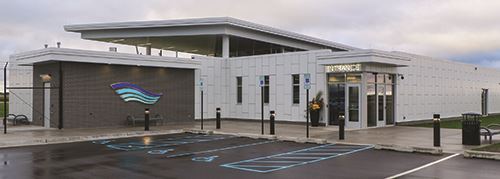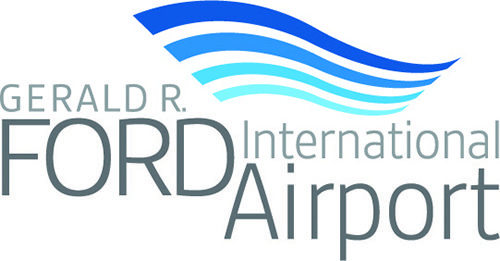Creating a better workspace was the driving force in early 2020 when executives at Gerald R. Ford International Airport (GRR) committed to building a new operations center. In addition to housing everyday operations functions and equipment, the $8.5 million building includes an upgraded emergency operations center for the Grand Rapids, MI, airport.
At a time when many employers are scaling back traditional offices in favor of work-from-home arrangements, airport operators still need the bulk of their teams on site. However, that doesn’t mean they are satisfied with status quo facilities.
 Creating a better workspace was the driving force in early 2020 when executives at Gerald R. Ford International Airport (GRR) committed to building a new operations center. In addition to housing everyday operations functions and equipment, the $8.5 million building includes an upgraded emergency operations center for the Grand Rapids, MI, airport.
Creating a better workspace was the driving force in early 2020 when executives at Gerald R. Ford International Airport (GRR) committed to building a new operations center. In addition to housing everyday operations functions and equipment, the $8.5 million building includes an upgraded emergency operations center for the Grand Rapids, MI, airport.
Construction on the single-story building (with partial basement) started in early 2021 and was completed in September 2022. Lisa Carr, the airport authority’s public safety and operations director, reports that the project stayed on schedule despite encountering supply chain delays and cost increases.
|
Project: New Airport Operations Center Location: Gerald R. Ford Int’l Airport — Grand Rapids, MI Size: 12,000 sq. ft. (single story with partial basement) Features: Enhanced technology, including new video wall; conference room & break room; heated parking bay for operations vehicles; snow melt system on sidewalk Cost: $8.5 million Funding: Local funds Construction: Early 2021–Sept. 2022 Architect: DLZ of Michigan General Contractor: Pioneer Construction Furnishings Manufacturer: Haworth Furnishings Dealer: Interphase Inc. Subcontractors: Buist Electric; Burggrabe Masonry; Cripps Fontaine Excavating; CS Erickson; Evans; Forman Glass; Gale Plumbing & Hydronics; Grand Valley Automation; Harder & Warner; Kosters & De Vries; Level 5 Commercial Finishing; Metal Tech Building Specialists; Parkway; Peter Basso Associates; Praise Companies; Prein & Newhof; SecurAlarm; VanLaan Concrete Construction; Van Dyken Mechanical; Van Dellen Steel; Versatile Roofing Systems; Tele-Rad; Total Fire Protection; Westmaas Electric Key Benefits: More space/better work environment for staff; built to withstand extreme weather conditions |
Responding to Growth
The new airport operations center is located east of the terminal, and includes both airside and landside access. The building is staffed 24/7 with one to eight people as need dictates.
With approximately 12,000 square feet of space, the new facility resolves former overcrowding issues for the airport. Previously, the Emergency Operations Center (EOC) was housed in the airport rescue and fire fighting (ARFF) station, and the operations and communications teams worked out of a cramped area on the mezzanine level.
The EOC is designed to support both airport tenants and mutual aid agencies from Kent County during a wide variety of emergency situations. The new facility includes a data center, video walls and special document review spaces, plus an office, conference room and break spaces. It has room and equipment for training, as well as space employees can use to work independently when their shifts overlap.
“This fixed a lot of problems that came with the overall growth of our airport,” explains Airport Operations Manager Ashley Lucas.
In 2019, GRR served 3.58 million passengers, an increase of 10% from the previous year and a jump of more than 40% from 2015. According to reports on the airport’s website, it handled 2.58 million passengers in 2022 through September.
In a second construction phase planned to begin this spring, the airport will relocate its ARFF facility to a site adjacent to the new operations center.
“The overall need was to bring the two halves of the team into their own space with an appropriate work environment,” Lucas explains. “Neither the operations or communications teams had a break room, there were too few desks [in their previous locations], and the temperatures were often either too hot or too cold. Now, they have ergonomic desks that they can stand or sit at, plus updated technology, including a video wall for flight arrivals and departures, weather, security cameras and other pertinent information.”
Shelter From the Storms

Project architect DLZ Michigan designed the operations center to meet Federal Emergency Management Agency (FEMA) requirements, including the ability to withstand winds up to 250 mph. The new facility also has redundant technologies and communication channels to ensure that services can continue during all types of emergencies, including severe weather.
Although DLZ had worked with several airports and public safety organizations in the past, this was the first airport operations center it has designed. Jason Vetne, AIA, LEED AP, the company’s architect and project manager for the new facility at GRR, says one key to success was working closely with airport personnel to develop a comprehensive assessment of current and future needs.
“Our goal with any client is collaboration,” he relates. “Our planning process had to account for what direction they thought the development of the campus was headed, and that was a moving target. A lot of the design process for any project involves precedent studies to evaluate options. We shared what has worked in the past and what hasn’t, and we interviewed all the stakeholders to compile a detailed needs assessment.”
 Lucas agrees that it was important to ask employees from the operations and communications teams about their needs and wishes for the new facility. “We started with the people who use the equipment themselves, asking what they had now and what could make their workstations better,” she explains. “It was very employee-driven to find the upgrades for furniture and technology that made sense.”
Lucas agrees that it was important to ask employees from the operations and communications teams about their needs and wishes for the new facility. “We started with the people who use the equipment themselves, asking what they had now and what could make their workstations better,” she explains. “It was very employee-driven to find the upgrades for furniture and technology that made sense.”
Key elements include new Samsung video screens, sit/stand desks manufactured and installed by Evans Consoles, and other furnishings from Haworth.
Challenges du Jour
As with most construction in the past couple years, the project at GRR encountered delays caused by supply chain disruptions. Labor shortages and increased material costs were also prevailing issues. In fact, right after general contractor Pioneer Construction won the project bid, its delivery time for steel joists doubled from 20 weeks to 40 weeks. Moreover, a pair of 150-kVA diesel generators the facility needs to ensure operations during power outages, were scheduled to arrive by early summer 2022, but they didn’t get delivered and installed until October.

Ross Geurink, a project manager with Pioneer, reports that careful and copious amounts of planning in the early stages and throughout construction helped keep the overall project on schedule. Sometimes, the team had to switch to alternative suppliers.
Geurink adds that the extensive and intricate technology systems being installed made it vital for all subcontractors involved in the project to maintain clear and continuous communication.
“It starts even before we’re on board with the architect, who had a technology consultant to help design the bid documents,” he explains. “It’s important to know which work categories will complete which scope of work. Once they started getting this equipment procured, we scheduled system integration meetings to talk with those folks so we had a plan in place for when we started actually installing this equipment. Our main role is to help facilitate communication between all the different trades. We need to understand the system and bring the different experts together to make sure everything functions correctly.”
Keeping all airport teams operational while transitioning to the new facility also required ingenuity. During the three days while key communication equipment was moved to the new facility, airport staff worked with mobile radios stacked on carts. “It wasn’t ideal, but they made it work,” says Lucas.


 facts&figures
facts&figures

